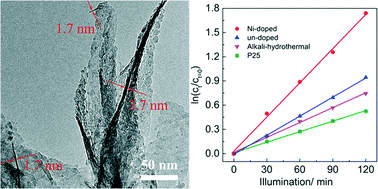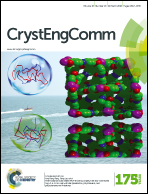Facile synthesis of Ni-doped TiO2 ultrathin nanobelt arrays with enhanced photocatalytic performance†
Abstract
Because of the high specific surface area and enhanced charge migration, TiO2 with unique belt-like nanostructures finds promising applications in various fields such as photocatalysis, dye-sensitized solar cells, gas sensors, and Li-ion batteries. In the current study, a solution combustion procedure was firstly adopted to prepare a black water-proof precursor. The black precursor interacted with H2O2 at ambient temperature, achieving a precursor solution that is capable of fabricating hydrogen titanate (H2Ti2O5·H2O) nanobelt arrays on metallic Ti substrates at 60 °C. Subsequent calcination in air at 400 °C achieved arrays of ultrathin anatase TiO2 nanobelts of ca. 2–4 nm in thickness. The addition of nickel nitrate in the combustion solution achieved the Ni-doping into the resultant TiO2 nanobelts, which did not alter the nanobelt structure but significantly reduced the band gap from 3.2 eV to 2.9 eV. When compared with the commonly alkali-hydrothermal synthesized anatase TiO2 nanobelts, the present ultrathin nanobelts exhibited much improved photocatalytic activity when utilized to assist photodegradation of rhodamine B in water. The ultrathin nanobelt structure is believed to contribute to the high specific surface area, the much reduced charge migration path, and the enhanced charge transport along the longitudinal direction. The appropriate Ni-doping further enhanced the photocatalytic performance, because of the increased light harvesting efficiency and reduced charge recombination.


 Please wait while we load your content...
Please wait while we load your content...